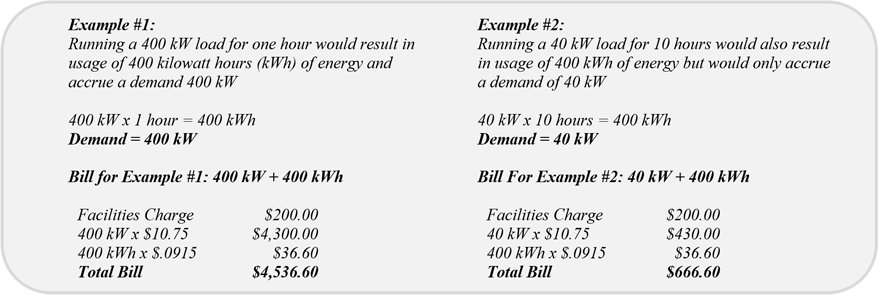Understanding the Demand Charge
Demand, expressed in kilowatts (kW), is the total amount of electricity being used by a customer during a defined time period. Reedsburg Utility Commission (RUC) records demand over a 15-minute interval. The customer is charged for the highest 15-minute demand recorded on the meter during a month. After RUC reads the meter each month, the demand is reset to zero and the meter starts over, recording the highest 15-minute demand for the next billing period.
Demand charges are based on each customer’s maximum 15-minute demand on RUC’s distribution system each month. Demand is measured in kilowatts (kW). Customers are billed according to kW of demand for their rate.
To demonstrate how the demand charge can affect an electric bill, here are two examples:

Why are the bills so different?
The actual energy (kWh) used is the same, 400 kWh. The difference between the bills is based entirely on the highest demand recorded during any given 15-minute period that month.
Why have a demand charge?
Demand charges are the way RUC pays for generation capacity it needs to meet the demand of its customers. RUC pays its wholesale power supplier, WPPI Energy, for energy and demand and bills the customers accordingly.
Are demand charges unique to RUC?
No. Demand billing is used consistently throughout the electric utility industry.
How can demand charges be reduced?
To reduce demand charges, consider examining your operation:
• Consider energy efficiency opportunities, focusing on those opportunities that reduce peak demand.
• Stage equipment operation. Does all of the equipment need to be running at the same time? If not, what can be turned off while other equipment is running? The result may be a significant savings in your monthly demand charge.
• Understand when your meter is read by RUC and modify your behavior to take advantage of billing periods. Large Power customers are read on the first of the month.
For example, you must test your irrigation system. If you haven’t used the irrigation system during any part of the current month, it may be best to wait until the next month to test the system. Even for a short test, you are billed for the energy used by the irrigation system, plus a demand charge for the entire month. By waiting a few days, you could move that demand charge into a month when you’ll be using the irrigation system anyway, saving an extra month’s demand charges.